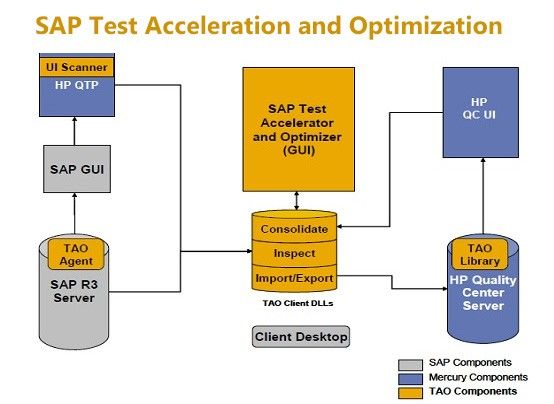SAP TAO (Test Acceleration and Optimization)
Definition or Meaning - What is SAP TAO?
Full form or SAP TAO stands for (Test Acceleration and Optimization), SAP has introduced Test Acceleration and Optimization for all its customers in association with Focus frame which was later acquired by Hexaware. True to its name the module provides aid in accelerating the speed by which automated test cases are created for SAP solutions for end to end scenarios. This acceleration is accomplished by virtue of automating the creation of test components for only a few specific transactions related to SAP.
Later on these test components are uploaded automatically by the HP application on SAP Quality Center. First, only the draft scenarios are created which are meant for single transactions, and then these are put together in a scenario test case. The SAP TAO also assist with the maintenance of components and test cases by merging them into SAP Solution Manager’s Business Process Change Analyzer.
SAP TAO works hand in hand with Quick Test Professional (QTP) and Quality Centre (QC), in which QTP works as the execution engine and all the test scenarios are created and driven from QC through the different business components. SAP TAO also helps in streamlining the maintenance and creation of ERP business processing testing.

Although SAP TAO supports quite a few technologies, the main ones are the User interfaces which are listed below:
- CRM Web UI
- SAP GUI
- Web GUI (on SAP ABAP servers) and Web Dynpro ABAP.
- Java Web Dynpro, SAP Portal, and Web (which is available on SAP Java systems or third-party servers)
Tools assimilated with SAP Test Acceleration and Optimization:
- SAP Solution Manager Adapter: this tool assists in transferring the requirement to HP Quality Centre and then transferring the HPQC result back to the Solution Manager.
- HP Quick Test Professional (QTP): this tool comes in handy for performing execution of the test scripts.
- HP Quality Centre: Application Life Cycle Management or also known as ALM is a test management tool primarily used for manual and automation testing. The Business Process Testing module of HPDQC is used for consolidating the components created from SAP Test Acceleration and Optimization.
- Object Spy is also a tool which helps in the retrieval of the information identifying the UI elements.
Benefits of SAP TAO (Test Acceleration and Optimization)
- Subject Matter: Experts are not required for developing the automated test cases
- Testing Deployment: reduces the total amount of time taken for creation and building executing the test scripts
- Reuse test: SAP Test Acceleration and Optimization removes the need for creating new tests in case of a component change. If one component changes in a group of test, that component can be replaced and later re-consolidate the same test.
- Maintenance: Eradicates the record and replay activities and significantly reduces the overall maintenance cost.
- Robustness: The SAP Test Acceleration and Optimization inspection process ensures that SAP Test Acceleration and Optimization (TAO) tests are more vigorous during changes. The Inspection process checks the data content with a module and is not restricted to only the screen object behavior.
Customer Pain Points
- In most of the situations, there is very little time available for executing the regression tests for critical business processes which eventually leads to insufficient test coverage.
- The Acceptance tests require a lot of time more time and manual testers due to a number of errors not fixed beforehand.
- Inadequate test coverage leads to a higher amount of defects not found before cut-over of changes from test to production landscape
- The overall costs for manual testers who perform regression tests are much higher.
- The costs required for fixing errors in the production landscape is very high.
SAP Test Acceleration and Optimization is a very efficient tool which increases the overall speed of creating automated test cases which leads to reduced costs and minimal errors.